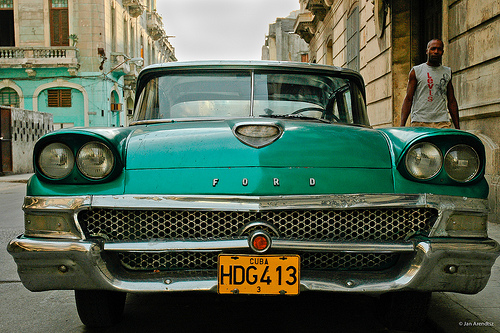The classic 1950s cars on the streets of Havana are much admired by foreigners, yet the reality for most Cubans is a lot more mundane. For them, owning a car – any car – remains a dream, albeit one which has been reawakened by economic reforms and moves towards normalising relations with the US.
But around the world, the car ownership dream has turned into a nightmare of congestion, pollution and disrupted communities. Cities in middle-income countries seem to be worst affected, despite having relatively fewer cars. There are real concerns that Havana might soon have the traffic – and air quality – of Mexico City or Bangkok.
So, as Cuba opens up and moves into the post-Castro era, is it doomed to follow this car-dependent road to development?
To answer this, we need to look at how cities around the world have dealt with the emergence of cars and, much later, the problems associated with them. UCL professor Peter Jones has identified three stages in global urban mobility policies.
At first, cities sought to accommodate an inevitable increase in vehicles. Massive spending on roads and related infrastructure facilitated the use of private cars, the symbol of individual freedom and aspiration.
By the 1970s it became clear that no amount of public investment could solve the problem of congestion. Those new roads would simply be filled by more cars. The objective therefore shifted towards maximising the movement of people (by whatever means), which meant expanding public transport. Pedestrian areas, parking controls, speed restrictions and fines were all deployed to restrict the use of private cars and encourage people onto buses or trains.

Roxana Gonzalez / Shutterstock.com
Around the turn of the millennium, we entered the third stage. In some countries the link between rising incomes and increased car travel broke down, fewer young people bought cars, and people with higher incomes preferred to live in city centres. Cars lost some of their status.
Evidence was mounting, meanwhile, of the damage more traffic was doing to human health and the climate. Simply providing mobility was no longer good enough. Transport in a truly “liveable city” had to factor in social inclusion, public health and environmental sustainability.
But achieving the “liveable city” is made difficult by earlier policies. Dependency on cars had led to the development of low-density cities, where many people can’t access jobs or facilities without a vehicle. The communities that were disrupted by new roads or motorways are difficult and expensive to restore, while sedentary, car-dependent lifestyles are hard to change.
The country that rejects the car?
Today Havana has an opportunity to lead. In some important ways, Cuba has been decades ahead of the rest of the world. The 1959 revolution resulted in Cuba making an early and abrupt shift from stage 1 (more roads, more cars) to stage 2, with its emphasis on collective public transport. A US trade embargo cut off the main supply of new vehicles, and Cuban citizens weren’t permitted to import cars themselves – they had to be given them by the government.

Rostislav Ageev / Shutterstock
These restrictions explain why so many classic cars have been kept in service, and its effects are still visible in Havana today. Compared to comparably wealthy cities elsewhere in the world, the Cuban capital’s relative lack of cars means most people still walk everywhere and street life is exceptionally vibrant.
In 2013, the government lifted the ban on sales of private vehicles, yet even used cars remain too expensive for most people. With cars still a luxury, big improvements in access could be made for relatively little cost if investment remains focused on pedestrians, cyclists and public transport. Havana has a unique opportunity to “leapfrog” beyond other cities that are now moving into stage 3, to create a world-leading liveable city.
However, in one important respect Havana is still stuck in the past: those few private cars that are found in the city enjoy unrestricted primacy over the roads. Drivers aren’t troubled by parking controls, congestion charges or limited traffic areas. This has exacerbated inequality of access and contributed to the public yearning for car ownership.
When public transport dramatically deteriorated during Cuba’s post-soviet “special period” in the 1990s, car ownership became an even greater privilege. Authorities have tried to restore bus services ever since, though they have lacked sufficient funds. In the post-Castro period, improved relations with the US and other trading partners may eventually bring investment that could be used for bus lanes, cycle-ways and mass transit – as long as pressure to focus primarily on privately owned cars is avoided.
Havana is therefore at a turning point. Unless current trends are checked, mobility and access will become more unequal, and the Habaneros’ liveability will be irrevocably damaged by unrestrained traffic growth. A clear vision and strong political leadership will be needed to seize the opportunity. For now, both the national and city-wide transport authorities are making all the right noises.

MJ Prototype / shutterstock
Havana is well-placed to learn from other cities that have gone through similar periods of change. Many made big investments in subways, light rail or bus lanes, with meagre results due to poor patronage, incorrect pricing or lack of regulation and investment over time. “Soft” investment into key capabilities such as modelling transport systems, urban planning and user-centric design aligns well with the open data push that many liveable cities are grappling with today.
However, three cities identified by the UN and the Economist Intelligence Unit – Barcelona, Copenhagen and Curitiba in Brazil – went a different route. There, smaller interventions such as pedestrianised streets or cycle lanes triggered positive chain reactions. In each case, attitudes shifted before car dependency had even peaked.
In Havana, small interventions like public bike hire schemes or more frequent buses with information displays could play a vital cultural role. Such moves would help facilitate a shift away from traditional perceptions of the car representing the future of urban mobility, and from the dream of car ownership as a symbol of both wealth and “freedom”.
![]()
James P. Warren, Senior Lecturer, Engineering and Innovation, The Open University; Adriana Ortegón-Sánchez, Research Associate, Department of Civil, Environment and Geomagnetic Engineering, UCL, UCL, and Emily Morris, Research Associate, Institute of the Americas, UCL, UCL
This article was originally published on The Conversation. Read the original article.



